Black spiders have long been a source of fear and fascination for people worldwide.
These arachnids are no exception in Kansas, with various black spider species making their homes in the region.
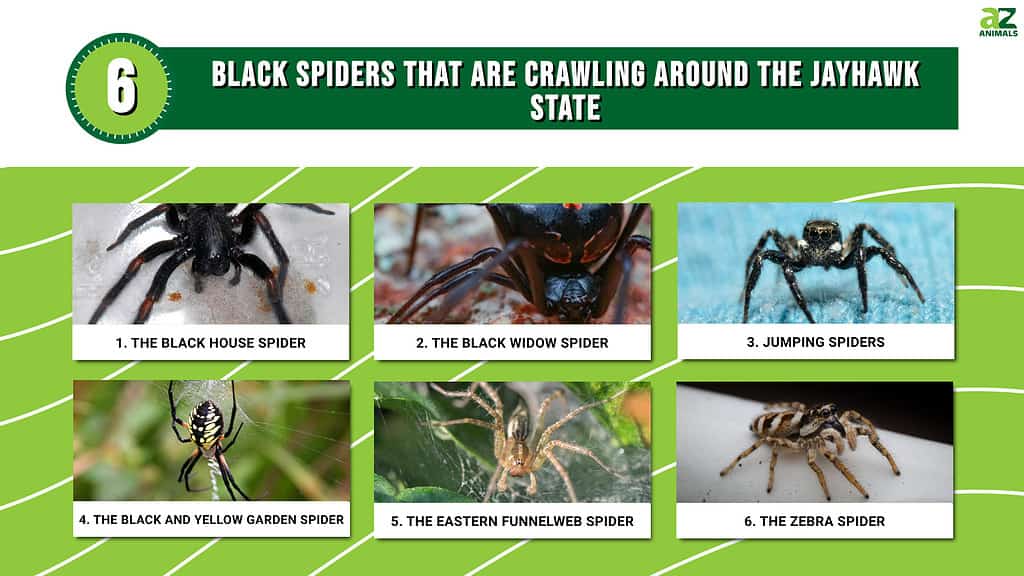
While some of these spiders are harmless, others can pose serious health risks to humans.
Today, we discover six black spiders in Kansas. We explore their physical characteristics, habitats, behavior, and associated health risks.
#1: The Black House Spider
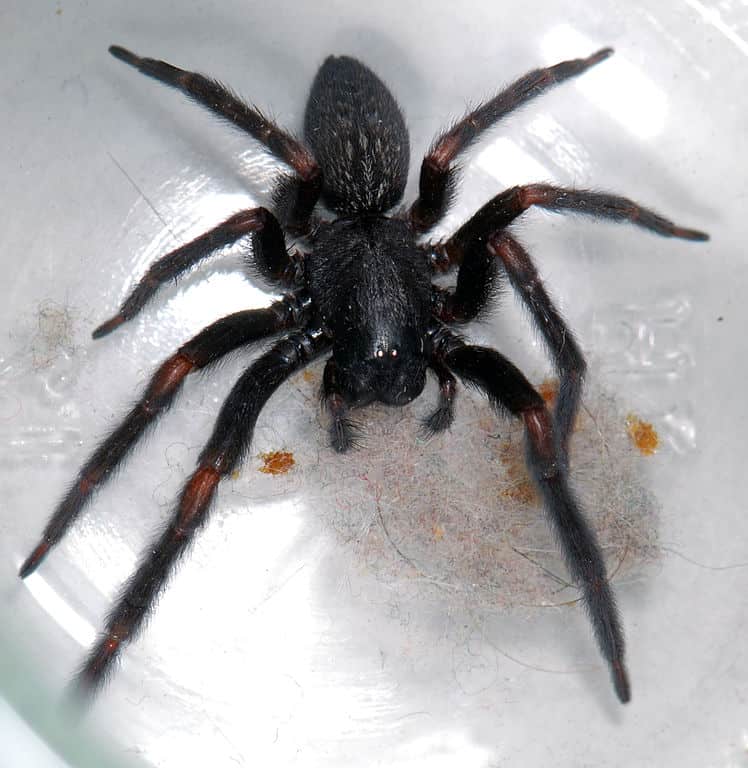
The blackhouse spider is known for their distinctive black color and web-weaving abilities.
©Peter Halasz (User:Pengo) / CC BY-SA 2.5 – License
Black house spiders, scientifically known as Badumna insignis, are a common spider species in Kansas.
They’re known for their distinctive black color and web-weaving abilities. This often results in them inhabiting homes and buildings.
Size and Color
Adult females typically measure 0.4-0.7 inches long, while males range from 0.3-0.5 inches. Their bodies are typically cylindrical, with a slightly flattened appearance. Black house spiders are predominantly black, with a distinctive glossy sheen to their carapace.
Among the most distinctive features of black house spiders is the presence of a white or cream-colored marking on the top of their abdomen. This marking is often described as a “teardrop” or “leaf” shape and can vary in size and shape depending on the individual spider.
Life Cycle
Black house spiders have a relatively short life cycle, with females typically living for around two years and males for up to one year. So let’s explore the spider’s complete life cycle.
- Reproduction and mating habits. Male black house spiders typically seek out female spiders to mate with. They use pheromones to locate potential partners. After mating, females typically produce a single egg sac containing 50-200 eggs.
- Egg sacs and hatching process. Black house spider egg sacs are typically small, white, or cream-colored and can be found attached to a web or in a protected location such as under bark or rocks. The eggs hatch in 2-3 weeks, and the spiderlings emerge through several molts as they mature into adult spiders.
- Development stages. After hatching, black house spiderlings stay with their mother briefly before dispersing and beginning their independent lives. As they grow, they shed their exoskeletons several times and continue to develop into adult spiders. Adult males often die shortly after mating, while females continue to mate and produce egg sacs throughout their lifespan.
Prey and Hunting Habits
Black house spiders are primarily nocturnal and typically spend the day in a retreat, such as a crack in the wall or under furniture.
As predators, blackhouse spiders feed on various insects, including:
They typically capture their prey by weaving webs to trap their victims.
Unlike other species of spiders, blackhouse spiders are not known for actively hunting their prey. Instead, they wait for insects to become trapped in their webs.
Defensive Mechanisms
Like many spiders, blackhouse spiders can bite when they feel threatened.
But their venom isn’t considered dangerous to humans. It only causes mild symptoms such as swelling and pain.
When threatened, blackhouse spiders typically retreat or hide rather than attack.
#2: The Black Widow Spider
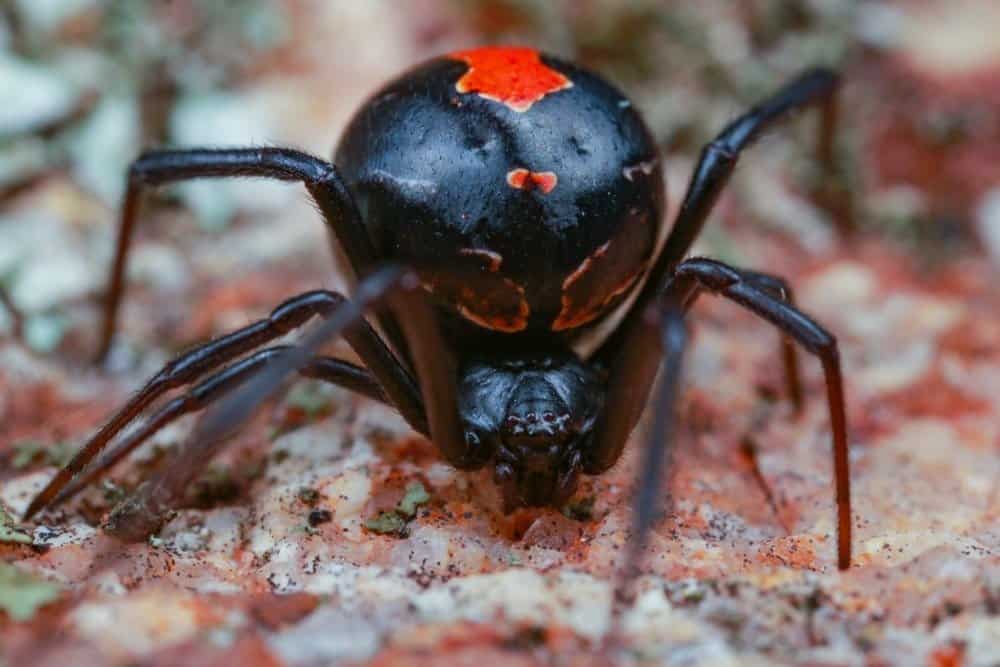
Black widow spiders are easily recognizable with their distinctive black bodies and red hourglass-shaped markings.
©Peter Yeeles/Shutterstock.com
Black widow spiders, known scientifically as Latrodectus mactans, are among the world’s most infamous and feared arachnids. They’re found throughout North America, including in Kansas.
Black widow spiders are easily recognizable with their distinctive black bodies and red hourglass-shaped markings.
Size and Color
Black widow spiders are typically 1.5 inches long, including their legs. They have a shiny black color.
Females are larger than males, with a round abdomen and long, spindly legs. Males are usually light brown with yellow or white markings on their backs and bellies.
Distinctive Markings
The most recognizable feature of black widow spiders is their distinctive red hourglass-shaped marking on the abdomen’s underside.
But not all black widows have this marking. Some may have red spots or no marking at all. Note that the marking is only present on female black widow spiders.
Venomous Fangs
Female black widow spiders possess two fangs at the front of their mouth. They use them to inject their venom into their prey or in self-defense.
Their venom is considered among the most potent of all spiders found in North America.
But bites from black widow spiders are not usually fatal to humans.
Habitat
In Kansas, black widow spiders can be found in various habitats, including outdoor areas such as gardens and wooded areas. You’ll also find them in indoor environments like basements and garages.
Be aware of their presence in these areas and take precautions to avoid contact with them.
#3: Jumping Spiders
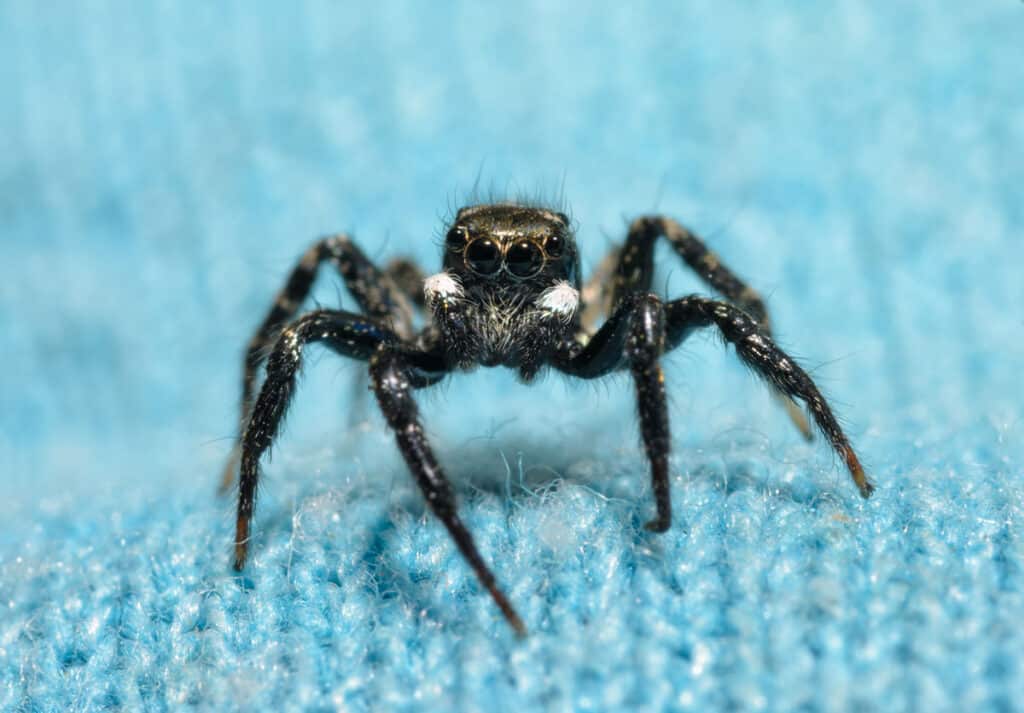
With their large, forward-facing eyes and incredible agility, jumping spiders are among the most amazing
arachnids
in the state.
©Sari ONeal/Shutterstock.com
Jumping spiders (scientific name: Salticidae) are known for their distinctive appearance, behavior, and hunting techniques.
With their large, forward-facing eyes and incredible agility, jumping spiders are among the most amazing arachnids in the state.
Size, Color, and Shape
Jumping spiders are typically small to medium-sized, ranging in size from 0.25-1 inch in length.
They come in various colors, including black, green, gray, and brown.
Moreover, many species have colorful markings on their bodies.
Jumping spiders have a compact body shape, short legs, and a rounded abdomen.
Distinctive Eye Arrangement
Spiders’ most distinctive features among jumping are their large, forward-facing eyes. These eyes are arranged in a unique pattern, with two large eyes in the front and two smaller eyes positioned behind them.
This gives jumping spiders excellent depth perception and the ability to accurately track moving objects.
Hair and Sensory Abilities
Jumping spiders are covered in dense hair. This helps them to detect:
- Air currents
- Vibrations
- Changes in light
They use this information to navigate their environment and locate prey. Jumping spiders also have excellent vision and can see both ultraviolet and polarized light.
#4: The Black and Yellow Garden Spider

The black and yellow garden spider is easily recognized by its distinctive black and yellow markings, and it has long been admired by gardeners and nature enthusiasts alike.
©iStock.com/AwakenedEye
Known scientifically as Argiope aurantia, this spider is found in various regions of the United States, including Kansas.
This species is easily recognized by its distinctive black and yellow markings, and it has long been admired by gardeners and nature enthusiasts alike.
Coloration and Markings
The black and yellow garden spider is so named for its black and yellow coloration, arranged in a series of stripes and spots on its body.
The spider’s cephalothorax (the head and chest region) is typically black, while its abdomen (the rear portion of the body) is a bright yellow color.
On the abdomen is a characteristic black and yellow zigzag pattern known as a stabilimentum. It helps the spider attract prey or repel predators.
The spider’s legs are also black and yellow banded, adding to its distinctive appearance.
Body Structure
The black and yellow garden spider can grow up to 1.5 inches long, with females typically larger than males.
The spider has eight legs, arranged in two rows of four. Its body is divided into two parts: the cephalothorax and the abdomen.
The cephalothorax contains the spider’s eyes, mouthparts, and legs, while the abdomen houses its reproductive organs and spinnerets (the structures that produce silk).
The spider’s spinnerets are located at the end of its abdomen and are used to produce the silk that the spider uses to construct its webs.
Geographic Range
The spider’s range extends across much of the U.S., with populations in every state except Alaska and Hawaii.
Within Kansas, the spider can be found throughout the state, although it is most commonly found in areas with abundant vegetation, such as:
- Gardens
- Meadows
- Fields
Preferred Habitat
The spider prefers to live in areas with abundant vegetation, where it can construct its webs to catch prey.
The spider is common in gardens, meadows, and forested areas. It typically builds its webs in areas protected from the wind and receives ample sunlight.
The spider’s preferred habitat provides it with the resources it needs to survive, including prey and shelter.
Web Construction
The spider is a skilled weaver and constructs intricate webs to catch prey.
The spider’s webs are typically orb-shaped and consist of several types of silk, each with a different purpose.
The spider uses radial threads to anchor the web, while sticky spirals are used to trap prey. The spider’s webs are constructed in areas with abundant prey, such as near flowers or areas with high insect activity.
Prey Capture
Once the black and yellow garden spider’s web is complete, it waits patiently for prey to trap itself in its sticky threads. When a prey traps itself, the spider immobilizes the prey with a venomous bite.
The spider then wraps the prey in silk and consumes it at leisure. The spider’s diet consists primarily of insects. But it may also occasionally consume other spiders or small vertebrates.
Reproduction
The black and yellow garden spider exhibits sexual dimorphism, with males and females exhibiting different behaviors during reproduction. Females are typically larger than males and have a more pronounced abdomen. Additionally, females have a row of spines on the underside of their abdomen, which they use to help anchor themselves to their webs. Males, on the other hand, are smaller, with longer legs relative to their body size.
Males typically approach females and attempt to court them, using a series of vibrations and movements to attract their attention.
If successful, the male mates with the female and then move on to find other potential mates. Females typically lay their eggs in a silk sac, which they guard until they hatch.
#5: The Eastern Funnelweb Spider
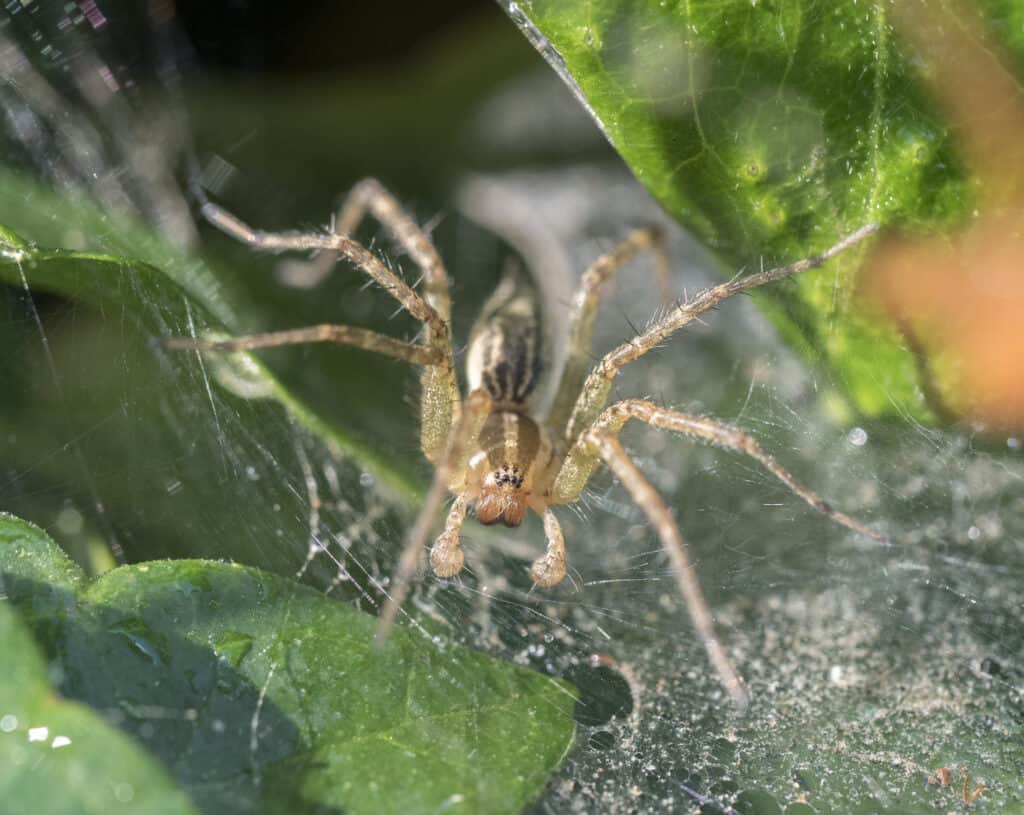
Funnel weaver spider, or grass spider, waiting for prey in its web in the garden.
©iStock.com/johnandersonphoto
Eastern funnel web spiders are also known as grass spiders or by their scientific name Agelenopsis.
The eastern funnel web spider is widely regarded as one of the world’s most venomous spiders.
This species, native to eastern Australia, has a distinctive appearance, aggressive behavior, and potent venom.
Despite its small size, the Eastern funnel web spider poses a serious health risk to humans, with bites often requiring immediate medical attention.
Physical Characteristics
The eastern funnel-web spider has a medium build, with adult females typically measuring around 0.6-1.4 inches long. Males are slightly smaller, measuring around 0.4-0.8 inches long.
This spider is easily recognizable by its shiny, dark brown or black-colored body and its large, powerful fangs, which can penetrate through fingernails and shoe leather.
Additionally, eastern funnel web spiders can be distinguished from other spiders by their spinnerets. They’re located at their abdomen’s tip and are used to spin silk for their funnel-shaped webs.
Behavior
Eastern funnel web spiders dwell on the ground and live in burrows they create in soil, leaf litter, or under rocks and logs.
They’re aggressive and possess the ability to strike rapidly and repeatedly when provoked.
Eastern funnel web Spiders are active hunters, feeding on insects, other spiders, and small animals.
They catch their prey by constructing a silken funnel-shaped web around the entrance of their burrow. When an insect or small animal enters the funnel, the spider attacks, biting its prey and injecting venom that quickly immobilizes it.
Venom
The venom of the eastern funnel web spider is highly toxic and can cause serious health problems in humans.
It contains a complex mixture of neurotoxins that target the nervous system and can cause:
- Muscle spasms
- Breathing difficulties
- Death in severe cases
The venom is especially dangerous to children, the elderly, and individuals with compromised immune systems. Seek immediate medical attention if bitten by an Eastern Funnel Web Spider.
#6: The Zebra Spider
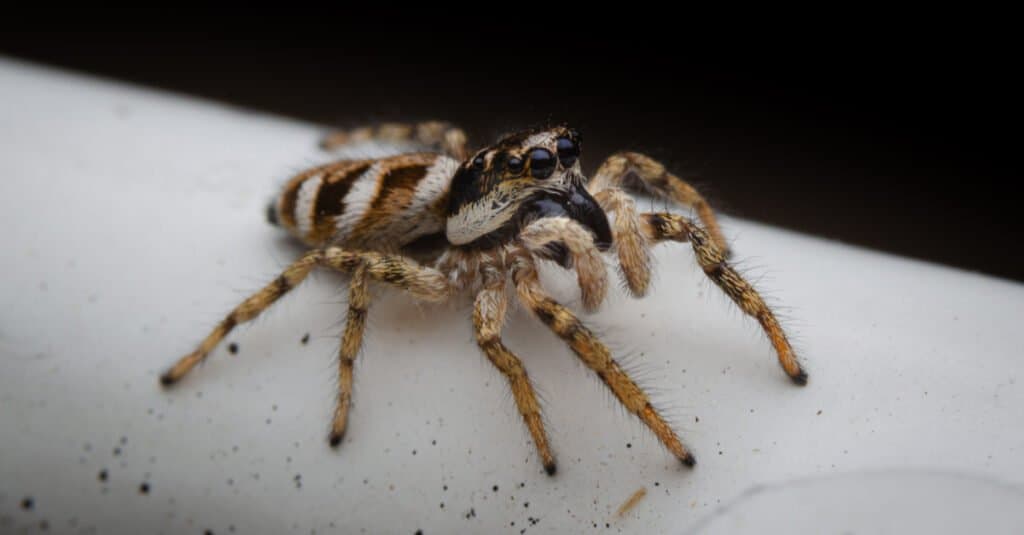
Recently, a new species has been making its way into the state—the zebra spider (scientific name:
Salticus scenicus).
©Mario.Pieper/Shutterstock.com
Kansas is known for its wide open plains, prairies, and diverse wildlife. Recently, however, a new species has been making its way into the state—the zebra spider (scientific name: Salticus scenicus).
While these tiny arachnids are not new to North America, their presence in Kansas is notable, as it expands their range further westward than previously thought.
Zebra spiders, also known as salticids, are a type of jumping spider found worldwide. These small, agile spiders have a distinctive black and white striped pattern on their bodies, which gives them their name.
Despite their small size (usually less than 0.4 inches long), zebra spiders are known for their impressive jumping ability, which they use to catch prey and escape predators.
Physical description
Zebra spiders have a compact body shape and eight legs, with two large, forward-facing eyes that provide excellent vision.
Their black and white stripes help to camouflage them on surfaces such as tree bark or rocks.
Habitat and behavior
Zebra spiders are in various habitats, including:
- Forests
- Grasslands
- Urban areas
They are active during the day and often hunt for small insects and other spiders.
Zebra spiders don’t build webs. Instead, they use their silk to construct small nests or shelters.
Diet and Prey
Zebra spiders are carnivorous and feed on small insects, such as flies, aphids, and other spiders.
They use their jumping ability to catch their prey and inject them with venom to immobilize them.
Recent Sightings and Reports
Zebra spiders are throughout the state, including urban areas such as Wichita and rural areas such as the Flint Hills.
Some individuals have even reported finding zebra spiders in their homes, suggesting that they’re adapting to the human-built environment.
The photo featured at the top of this post is © iStock.com/maria72
Thank you for reading! Have some feedback for us? Contact the AZ Animals editorial team.






